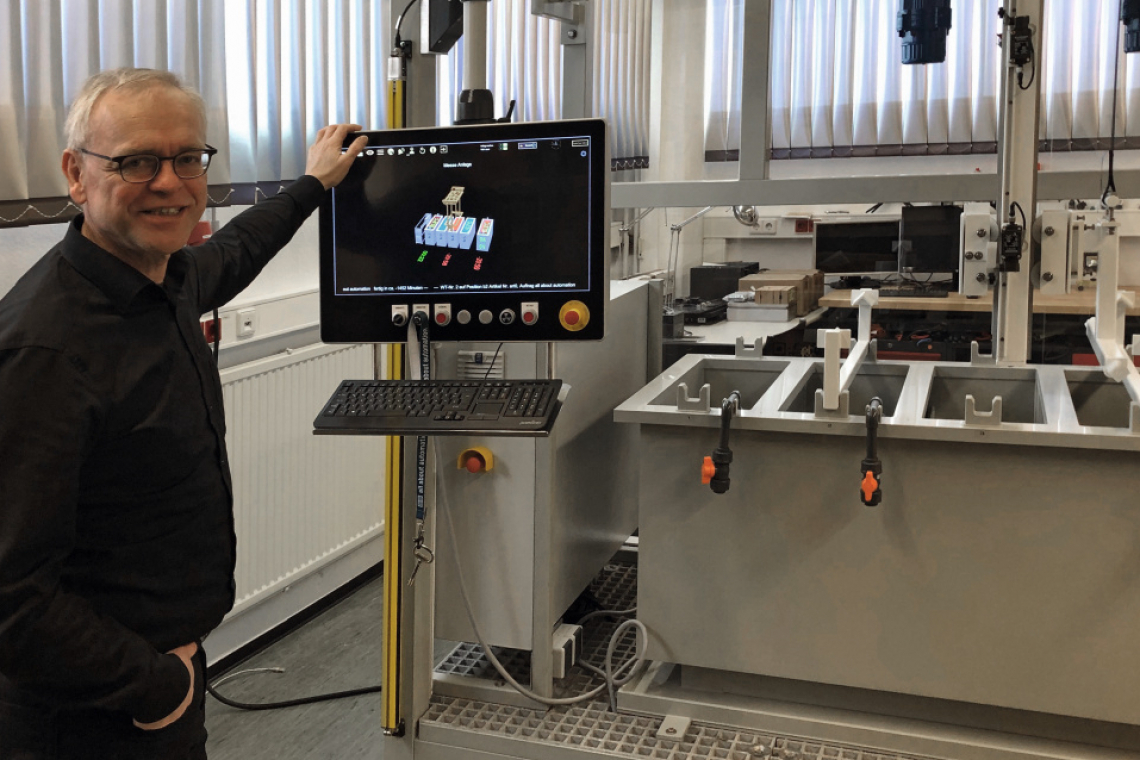Utikal Automation from Achstetten-Bronnen near Ulm is the industry expert when it comes to automation. After 35 years in business, the company is known worldwide - and is an indispensable link between traditional electroplating technology and the digitalization of production in electroplating.
35 years ago, in 1989, a small start-up took its first steps from a shared office in Ulm. The only employee at the time was Richard Utikal, a graduate engineer in automation technology. He had just started his own business and was working for IBM, which continued to rely on his expertise in programming and automation after closing its development department in the southern German city. "Compared to today, computers couldn't do anything back then," says Utikal with a grin, referring to devices such as the Commodore 64 with 64 KB of RAM and the rudimentary Basic programming language. "Collecting data wasn't even possible back then. Since then, there has been exponential growth in data processing," he says, tracing the arc from the late 1980s to modern times.
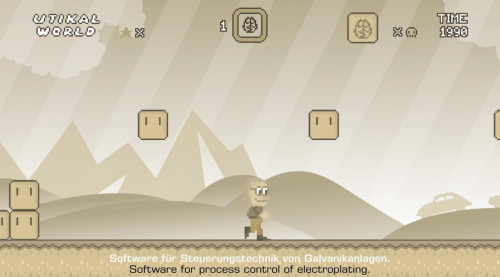 The company film with a retro look describes the relocations and development of Utikal Automation... (Photo: Screenshot)
The company film with a retro look describes the relocations and development of Utikal Automation... (Photo: Screenshot)
Production software as a model for success
Instead of sharing an office with a secretary for everyone back then, Richard Utikal now sits in the large conference room at his company headquarters in Achstetten-Bronnen, Baden-Württemberg. On a clear day, Ulm Minster can be seen in the distance from here.
Twelve employees now work for Utikal Automation in the rooms that branch off from a long corridor. Engineers, technicians and business people. Utikal came to electroplating technology a year after the company was founded with an order for the oldest electroplating company in Germany: Langbein-Pfannhauser Werke, whose branch in Vienna was interested in a control system. A few years later, the time had come and Galvcon, an automation software for electroplating plants programmed by Utikal Automation, conquered the market. Over the years, the programs Aracon for the automation of waste water treatment, Simcon for the simulation of processes and Fieldcon for maintenance and servicing were added. A complete package for automation and control in electroplating production.
Together with software for the commercial sector, for example from Softec, this results in comprehensive software equipment for companies in the industry, including hot-dip galvanizers, anodizers and operators of coil lines.
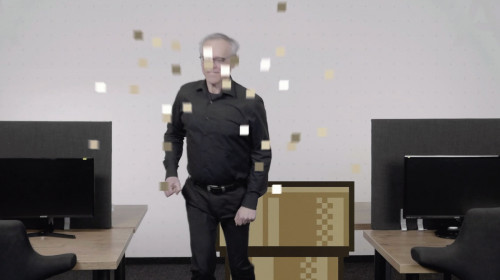 ...Next Level: Return to the present (Photo: Screenshot)
...Next Level: Return to the present (Photo: Screenshot)
Global Reach
The software is now of interest not only to companies in German-speaking countries, but worldwide. Utikal enters a few commands on the computer and a world map appears on the oversized LCD TV in the conference room, showing extensive connecting lines from Achstetten-Bronnen to New York, Mexico City, Shanghai, Mumbai, Dubai and many other cities and regions of the world. Word of the software's benefits has spread and experts with detailed industry knowledge are rare and in demand.
Accordingly, business is going well. A trip to Mexico to visit a customer is next on Richard Utikal's agenda. In Germany, he and his team recently hosted the Business Days with the best customers. Interest is high and the implementation of the first AI-supported production software based on Galvcon is also imminent this summer. Since 2020, the Achstetten-based automation experts have been working on creating a completely digital image of an electroplating shop. To this end, they have been cooperating with the Karlsruhe Institute of Technology (KIT) for two years.
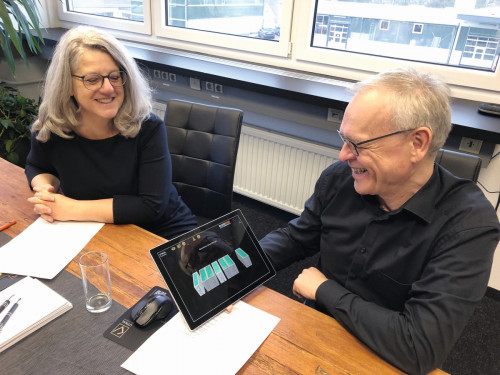 Richard Utikal describes the convenient use of the production software via tablet, next to Manuela Schmied-Wolfsbauer
Richard Utikal describes the convenient use of the production software via tablet, next to Manuela Schmied-Wolfsbauer
From software implementation to real-time simulation
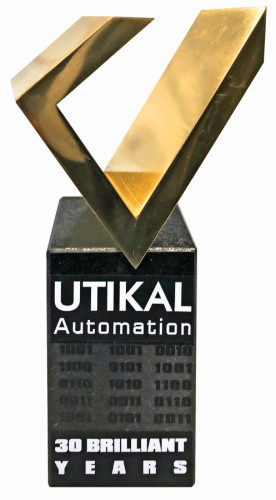 Utikal bust with logo, produced and coated by a customer for the 30th anniversaryIngeneral, however, business with electroplating production software is rather down-to-earth. Utikal or his team members travel to new customers, listen to their wishes and obtain detailed information about processes, loading concepts and programs. This often results in a specification sheet that serves as a blueprint for the project planning and implementation phase in-house. "We have standard modules that are customized for the customer. The customer's wishes are very rarely identical," explains the entrepreneur. This is followed by demonstrations at the customer's premises, where simulations are also used, and then the software installation in the electroplating shop. Production support and training ensure the successful use of the software.
Utikal bust with logo, produced and coated by a customer for the 30th anniversaryIngeneral, however, business with electroplating production software is rather down-to-earth. Utikal or his team members travel to new customers, listen to their wishes and obtain detailed information about processes, loading concepts and programs. This often results in a specification sheet that serves as a blueprint for the project planning and implementation phase in-house. "We have standard modules that are customized for the customer. The customer's wishes are very rarely identical," explains the entrepreneur. This is followed by demonstrations at the customer's premises, where simulations are also used, and then the software installation in the electroplating shop. Production support and training ensure the successful use of the software.
And service is also provided from a single source, as Manuela Schmied-Wolfsbauer, a long-standing employee at Utikal Automation and electroplating columnist, emphasizes: "We have control cabinet builders on hand and can also provide PCs and PLC controllers." She then talks about how complex projects can sometimes be. One of the projects she took part in a few years ago was at technology company Tyco TE in Austria. "The entire cables were replaced. Switch cabinets were then transported in and out of the two-storey electroplating facility by crane," recalls the communications specialist, who runs her own podcast and works at Utikal Automation alongside her management coaching agency.
While some projects like this require months of preparatory work, pure software implementations in medium-sized electroplating plants with two lines and five trolleys can be completed in a week, says Richard Utikal. If, as in the case of connector manufacturer ODU, complex visualizations are required on a huge screen in the entrance area with images of production in real time, more work is of course required. This is where so-called clients become active, which retrieve data from sensors at the production locations and use it for a real-time simulation. These simulations can then also be called up on tablets and computers. When it comes to control, the software can also be used in the home office.
Reducing complexity for all employees
What sounds complex does not have to be complex to use. "Our operating displays are compact and clear. We've even taken red-green ametropia into account, offer multilingualism and an analog clock display on request," says Schmied-Wolfsbauer. The connection to production is established via barcodes, which are used to report production progress. "This is faster and more convenient. Data collection has increased exponentially as a result," says Richard Utikal.
But what are the benefits of such a system? Utikal explains the differences between rigid and flexible control systems. Rigid control systems are suitable for large series that always run the same way, for example in strip electroplating or galvanizing plants. Here the throughput is very high anyway, sometimes at 100 percent. In mixed operations, however, the situation is different. Small and medium-sized series are run here. There are different programs with different processes. These flexible control systems are Utikal Automation's greatest expertise. "We've been doing this right from the start. We are leaders in this field," the Managing Director proudly emphasizes. With the systems from his company, the throughput in such electroplating plants is optimized and thus turnover is increased. "In most cases, the implementation of our systems for electroplating plants pays for itself after just one year," says the manager, promoting his technology. This increases throughput to around 95 percent. With AI, the software should even achieve throughput rates of 98 percent in mixed operations, according to the target. The range of customers is very broad: Utikal shows examples of logos from companies from all over the world on the screen in the conference room, such as Grauer & Weil in India, Galwano-Perfekt in Poland, Aalberts, Neutra Eloxal, ABB, De Martin, Siemens, Lufthansa Technik and the cooperation partner DEWE Brünofix.
Retrofit almost always possible
But what about retrofitting old systems? Of course, this depends on a variety of factors, but Richard Utikal is convinced that his technology can help any electroplating shop to achieve a modern and efficient production method, as he confirms that the software is even suitable for manual electroplating shops. If necessary, elements such as control cabinets need to be replaced. There are also no no-gos when it comes to processes. Manuela Schmied-Wolfsbauer does not accept the fears of older people that jobs could be lost because knowledge is being digitized and automated: "There is no danger of this, it just changes the picture". However, a certain affinity with computers is necessary, she admits. And this is more common among younger people than older people. A complete package of the various programs from Galvcon to Aracon to Fieldcon is rather rare. However, the control software for production and wastewater treatment is quite common in combination, including chemical stock management and a constant overview of pH values and layer thicknesses.
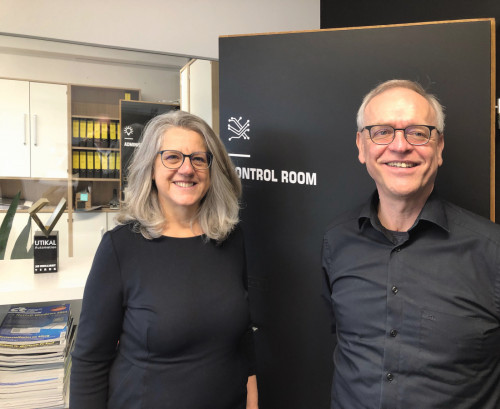 A long-standing team: Manuela Schmied-Wolfsbauer with Richard Utikal (Photos: Robert Piterek)
A long-standing team: Manuela Schmied-Wolfsbauer with Richard Utikal (Photos: Robert Piterek)
First version still running
Richard Utikal is also proud of the fact that no updates are required for his systems. "There are customers who have been using Galvcon for 30 years," he emphasizes and shows the first user interface, which he developed for his first customers in the early 1990s, on the conference screen. Even when computers and operating systems become outdated, the original software can be ported. Data can be transferred to Excel or other programs. "Many people use this for heating in particular," Utikal has observed. The improved efficiency of the systems thanks to his automation technology naturally also goes hand in hand with energy efficiency. An important topic in times when the price of electricity per kilowatt hour is at an all-time high. The experts also suggest further efficiency measures in consultations with customers about the right automation solution, such as solid state relays for heating. "They can be better controlled in terms of regulation," says Utikal. However, the potential for energy efficiency in electroplating plants is naturally exhausted at some point. After all, energy is essential for generating heat for the baths. And data security? This is ensured by completely isolating the system, as Utikal assures us. Access, even for remote customer support, is not secured via remote access, such as the insecure Team Viewer, but via Virtual Private Networks (VPN). Firewalls and router settings are also used.
A look back at hundreds of installations
250 system installations in electroplating and waste water technology as well as cleaning and exhaust air systems are the balance sheet after 35 years of Utikal Automation. Today, the company generates 1.6 million euros annually. And the outlook is positive. Richard Utikal and his team are currently preparing for the upcoming Surface Technology trade fair in Stuttgart in June. By the time Richard Utikal turns 65 in 2029, the succession should have been resolved and turnover should have risen to 2.5 million euros. It is currently unclear whether one of his two sons will take over the company one day. Manuela Schmied-Wolfsbauer is not worried about this. "Mr. Utikal is like a Duracell man," she jokes.
Photos: Robert Piterek

